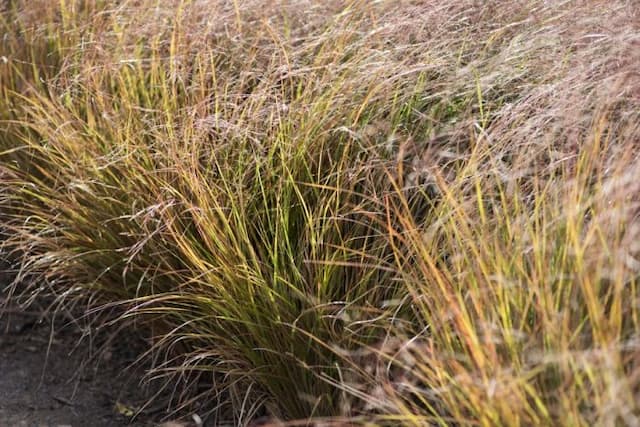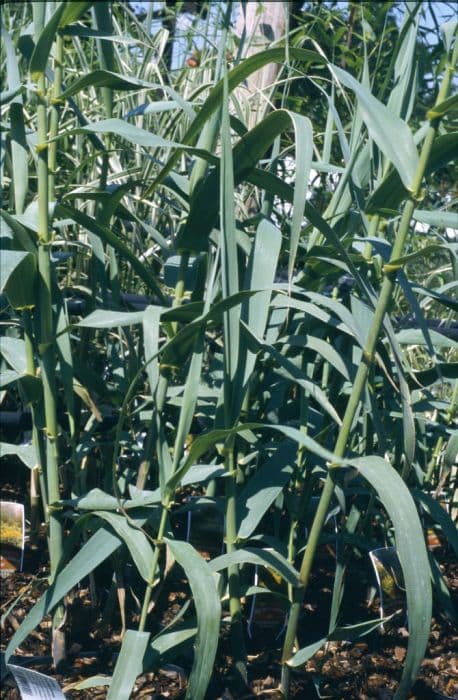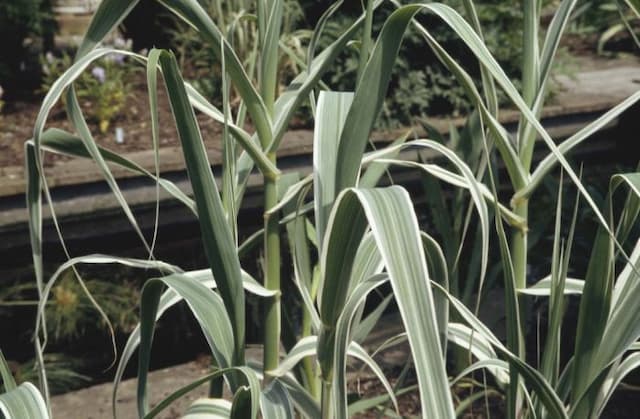African Feather Grass Pennisetum macrourum

ABOUT
Pennisetum macrourum, commonly known as African feather grass, is a perennial grass with a distinctive, graceful appearance. Its foliage is a rich green color, forming a dense clump with narrow leaves that cascade down in a fountain-like manner. The most striking feature of African feather grass is its long, slender flower spikes. These spikes are silvery-white and resemble tails, with a feathery texture that adds a delicate, airy quality to the plant. The flowers stand tall above the foliage, swaying gently in the breeze and giving the plant a soft, flowing look. As the plant matures, the flowers may take on a golden hue. Overall, African feather grass has an elegant, tufted appearance that can add movement and texture to garden landscapes.
About this plant
 Names
NamesFamily
Poaceae
Synonyms
African Feather Grass, African Fountain Grass, Tall Feather Grass
Common names
Cenchrus macrourus, Gymnotrix latifolia, Pennisetum latifolium, Pennisetum mezianum, Cenchrus mezianus.
 Toxicity
ToxicityTo humans
The plant known as African feather grass (Pennisetum macrourum) is not commonly listed as poisonous to humans. However, accidental ingestion of any plant material can cause discomfort or an allergic reaction in some people. If African feather grass or any other plant is ingested and symptoms develop, it is important to seek medical attention. Always be cautious and avoid eating plants that are not known to be edible.
To pets
African feather grass (Pennisetum macrourum) is not commonly listed as toxic to pets. However, ingestion of plant material can sometimes lead to gastrointestinal upset in animals, including symptoms like vomiting or diarrhea. If you suspect your pet has ingested parts of this plant and is showing adverse effects, please contact your veterinarian. It is generally a good practice to prevent pets from consuming plants not intended for their diet.
 Characteristics
CharacteristicsLife cycle
Perennials
Foliage type
Evergreen
Color of leaves
Green
Flower color
White
Height
5 feet [1.52 meters]
Spread
3 feet [0.91 meters]
Plant type
Grass
Hardiness zones
9
Native area
Africa
Benefits
 General Benefits
General Benefits- Erosion Control: Pennisetum macrourum, also known as African feather grass, has deep and extensive root systems that help stabilize soil and prevent erosion.
- Drought Tolerance: The plant is highly drought-resistant, making it useful for landscaping in arid and semi-arid regions.
- Agricultural Uses: It can be used as fodder for livestock, particularly in areas where other forage plants may not thrive due to poor soil or drought conditions.
- Habitat for Wildlife: African feather grass can provide habitat and cover for small wildlife, including birds and insects.
- Ornamental Value: With its tall, slender stalks and feathery plumes, it is often used in gardens and landscaping for its aesthetic appeal.
- Soil Improvement: It can contribute to the organic content of the soil through its natural life cycle, improving soil structure and fertility over time.
 Medical Properties
Medical Properties- This plant is not used for medical purposes.
 Air-purifying Qualities
Air-purifying QualitiesThis plant is not specifically known for air purifying qualities.
 Other Uses
Other Uses- Erosion Control: Pennisetum macrourum, also known as African feather grass, is often used in landscape restoration projects to stabilize soil and prevent erosion due to its robust root system.
- Ornamental Use: With its attractive feathery flower spikes, it is commonly used in gardens and parks for aesthetic purposes.
- Thatching Material: In some local communities, the tall grasses of African feather grass are used as thatching material for roofing.
- Livestock Fodder: While not a primary feed, in times of scarcity it can serve as fodder for livestock.
- Biofuel Production: Studies suggest the possibility of using Pennisetum macrourum for biofuel production due to its fast growth and high biomass yield.
- Weaving Material: The long, sturdy stems of African feather grass can be used in traditional weaving practices to create mats and baskets.
- Privacy Screens: When planted in dense rows, it can function as an effective natural privacy screen for homes and gardens.
- Soil Improvement: It can be used in crop rotation to improve soil structure and organic content when plowed back into the soil as green manure.
- Bioremediation: The grass has potential in bioremediation, removing heavy metals and other contaminants from the soil due to its fast growth and extensive root system.
- Mulching Material: Dried leaves and stems of African feather grass can be used as a mulch to conserve soil moisture and suppress weeds.
Interesting Facts
 Feng Shui
Feng ShuiThe plant African Feather Grass is not used in Feng Shui practice.
 Zodiac Sign Compitability
Zodiac Sign CompitabilityThe plant African Feather Grass is not used in astrology practice.
 Plant Symbolism
Plant Symbolism- Resilience: African feather grass, like many grasses, has an ability to spring back after being trampled or bent, representing the ability to recover from challenges.
- Adaptability: This species can thrive in a variety of climates and conditions, symbolizing the capacity to adapt to different situations in life.
- Growth: African feather grass grows quickly and spreads fast, making it a symbol of rapid expansion and the idea of continuously striving for growth.
- Freedom: The way the feathery plumes of the grass sway in the wind can evoke a sense of freedom and release from constraints.
 Water
WaterAfrican Feather Grass prefers consistent moisture but is tolerant of some drought once established. It is generally recommended to provide about an inch of water per week, either through rainfall or irrigation. During hot, dry spells, you may need to water twice a week, ensuring the soil is moist but not waterlogged. Apply water directly to the base of the plant to minimize wetting the foliage, using roughly 0.5 to 0.75 gallons per plant, depending on the size and soil conditions.
 Light
LightAfrican Feather Grass thrives in full sun conditions where it can receive at least six hours of direct sunlight daily. The best spot for this plant is an open area with clear exposure to the sky, away from the shade of larger trees or buildings. It can tolerate some light shade, but too much shade can result in reduced flowering and a less robust form.
 Temperature
TemperatureAfrican Feather Grass is well-adapted to a range of temperatures but performs best in conditions between 60°F and 80°F. It can survive temperatures as low as 20°F and as high as 90°F or above. The ideal growing conditions for this grass are warm days and cool nights.
 Pruning
PruningPruning African Feather Grass is important for maintaining its shape and encouraging healthy new growth. Cut back the foliage to about 3 inches above ground level in late winter or early spring before new growth begins. This annual pruning allows for a rejuvenation of the plant, promoting more vigorous and attractive foliage through the growing season.
 Cleaning
CleaningAs needed
 Soil
SoilAfrican Feather Grass thrives in a well-draining soil mix with a pH range of 6.0 to 7.0. A mix containing loamy soil, sand, and peat works well for this grass. Make sure to provide adequate drainage to prevent waterlogging, which can lead to root rot.
 Repotting
RepottingAfrican Feather Grass does not require frequent repotting. It can typically be repotted every 2 to 3 years, or when the plant becomes root-bound and the growth starts to slow down.
 Humidity & Misting
Humidity & MistingAfrican Feather Grass prefers moderate humidity levels but is quite adaptable and can tolerate the varying humidity conditions commonly found in home environments.
 Suitable locations
Suitable locationsIndoor
Place in bright light, well-draining soil.
Outdoor
In full sun, well-draining soil, space 2-3 ft apart.
Hardiness zone
7-11 USDA
 Life cycle
Life cyclePennisetum macrourum, also known as African feather grass, begins its life cycle as a seed, often germinating after a period of dormancy which can be broken by conditions such as temperature fluctuations or soil disturbance. Upon germination, it develops a root system and shoots that grow into juvenile plants; this stage is known as the seedling stage. As it matures, African feather grass enters the vegetative stage, characterized by rapid growth of roots and shoots, and the development of its distinctive long, feather-like inflorescences. Following the vegetative stage, it progresses to the reproductive stage, where flowers are produced that facilitate pollination, typically by wind. After successful pollination, seeds develop within the flowers, which are then dispersed by various means, including wind, animals, or human activity. The plant then either dies or enters a period of dormancy, completing its lifecycle, while the dispersed seeds may give rise to new plants, continuing the cycle.
 Propogation
PropogationPropogation time
Spring to summer
The African feather grass, commonly known as Pennisetum macrourum, is best propagated through seed. Seed propagation is the most popular method for this species. To propagate African feather grass by seed, one should scatter the seeds on a well-draining soil mix and lightly cover them with soil. The soil should be kept moist until germination, which usually occurs within 2 to 3 weeks. Optimal propagation time is in the spring, when temperatures are consistently warm, typically between 68 to 77 degrees Fahrenheit (20 to 25 degrees Celsius). Sowing the seeds during this season maximizes the chance of successful germination and establishment, allowing for growth into robust plants by the end of the growing season.









